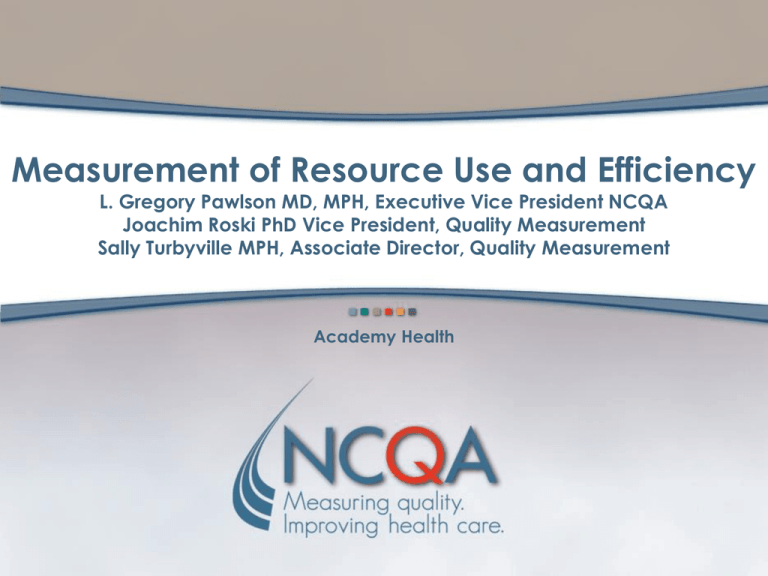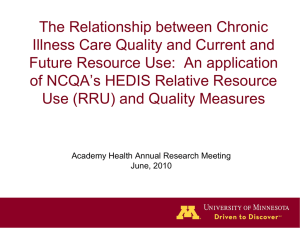Measurement of Resource Use and Efficiency
advertisement

Measurement of Resource Use and Efficiency L. Gregory Pawlson MD, MPH, Executive Vice President NCQA Joachim Roski PhD Vice President, Quality Measurement Sally Turbyville MPH, Associate Director, Quality Measurement Academy Health Why HEDIS® Plan Level Measures of Efficiency (cost-quality)? • Affordability of health care is a major concern; crowding out focus on quality at purchaser level • Understanding and influencing BOTH quality and utilization/cost is key to providing broader access to affordable health care • Health plans attempt to add value by favorably impacting quality as well as mitigating avoidable utilization/cost • NCQA health plan accreditation, which includes performance evaluation, is a lever to encourage performance assessment related to both quality and cost Academy Health June 2007 2 Potential Health Plans Impact on Costs Health Plan Functions Impact Disease Management Wellness Programs Benefit Design Network Design Provider Payment Utilization Provider Contracting Unit Price/Discount Focus of RRU Premium Admin. costs, Strategic considerations, etc Academy Health June 2007 3 Principles of Measuring Efficiency • Link measures of cost and quality in construction and reporting of measures • Build on existing quality measures (e.g., HEDIS®) • Add measures of cost-resource use • Methods must be transparent and fair • Standardized measures and data collection • Begin with what can be measured now Academy Health June 2007 4 Health Plan Efficiency: HEDIS Measures Quality Measures coupled with new Relative Resource Use (RRU) Measures for People with… • Diabetes • Asthma • Acute Low Back Pain • Uncomplicated Hypertension • Cardiac Conditions • COPD First year RRU collection in HEDIS 2007 First year RRU collection in HEDIS 2008 Academy Health June 2007 5 The RRU Measures • Reports the relative resource use for a health plan members with a particular condition when compared to their risk adjusted peers – Standard price table provided by NCQA to appropriately weight units of services rendered to members. – DOES NOT use episode groupers • When coupled with the related HEDIS quality measures, the RRU ratios provide a better understanding of the efficiency or value of services rendered by the plan Academy Health June 2007 6 Key Features of HEDIS RRU Measures • Costs are risk adjusted for: – Age – Gender – Presence of co-morbidities • Exclusions of other dominant conditions – Active cancer – HIV/AIDS – ESRD, etc. • Member cost capped if exceeds specified amount • Adjusted for enrollment and pharmacy benefit status (medical and pharmacy member months) Academy Health June 2007 7 Objective of Early Adopter Pilot • Pilot test analytic approach for full HEDIS data set (300+ plans) submission that is in progress (June 2007) • Do preliminary analysis of variation of quality and cost for adults with diabetes – Comprehensive Diabetes Care (CDC) and Relative Resource Use for People with Diabetes (RDI) HEDIS measures • Initial opportunity to examine performance between HMOs and PPOs • Gain further implementation experience prior to 2007 HEDIS data submission • Voluntary convenience sample of 20 HMO’s and 11 PPO plans (larger than initial pilot test of measures) Academy Health June 2007 8 Comprehensive Diabetes Care Quality Measures • Quality measure results based on 2006 HEDIS (measurement year 2005) using specifications for administrative only data collection • Quality measures included four process of care measures: – Annual Cholesterol Testing – Annual HbA1c Testing – Eye Exam – Monitoring for Kidney Disease • Calculated plan level diabetes measures composite rate – Unweighted average of measures • Created diabetes quality plan index – Individual plan composite rate divided by all-plan composite average Academy Health June 2007 9 RRU Measure in Diabetes • RRU ratio based on 2007 HEDIS Diabetes RRU specifications; – Measurement year 2005 (same as quality measures) • RRU results assess relative cost (i.e., standardized price weighted resource use) by service category: – Inpatient facility services (IP) – Surgery & procedure services (Surg) – Evaluation and Management (office visits) services (E&M) – Pharmacy, ambulatory use (Rx) Academy Health June 2007 10 Relative Resource Use Index for Diabetic Patients (RDI) • RDI calculated as ratio of observed-to- expected (risk adjusted average) standardized costs for patients with diabetes • RDI index calculated – RDI ratio divided by all-plan RDI ratio average • Measurement of weighted resource use - not unit price – NCQA standardized price tables – Cost is defined as the summarized weighted resource use Academy Health June 2007 11 Observed Resource Use (PMPM) HMO & PPO N=31 Academy Health June 2007 12 Total RDI & CDC N=31 Diabetes Care: Care: Quality Quality and and Cost Cost Diabetes 1.7 ▲=HMO ● =PPO CDC Index: Composite 1.5 1.3 1.1 0.9 0.7 0.5 0.3 1.7 1.5 1.3 1.1 0.9 0.7 0.5 0.3 RDI Index: Total Medical Services Academy Health June 2007 13 Variation in Pharmacy RDI & CDC N=31 Diabetes Care: Quality and Cost 1.7 1.5 CDC Index: Composite ▲=HMO r = .513, sig: .003 ● =PPO 1.3 1.1 0.9 0.7 0.5 0.3 1.9 1.7 1.5 1.3 1.1 0.9 0.7 0.5 0.3 RDI Index: Pharmacy Services Academy Health June 2007 14 Variation in IP Facility RDI & CDC Diabetes Care: Quality and Cost 1.7 r = -.466, sig: .025 HMO Only N=23 CDC Index: Composite 1.5 1.3 1.1 0.9 0.7 0.5 0.3 1.7 1.5 1.3 1.1 0.9 0.7 0.5 0.3 RDI Index: Total Medical Services Academy Health June 2007 15 Variation in Pharmacy RDI & CDC Diabetes Care: Quality and Cost 1.7 1.5 CDC Index: Composite HMO Only N=23 r = .512, sig: .013 1.3 1.1 0.9 0.7 0.5 0.3 1.9 1.7 1.5 1.3 1.1 0.9 0.7 0.5 0.3 RDI Index: Pharmacy Services Academy Health June 2007 16 Summary of Findings • PPO performance for both CDC and RDI appeared to vary to a greater extent than HMO performance. • For most categories, no correlation between cost and quality. • Positive correlation (r= -.52) between pharmacy costs and quality • Negative correlation (r= +.45) between inpatient facility costs and quality • Results seem plausible Academy Health June 2007 17 Limitations • Small overall sample size (n=31) • Data limited to commercially insured members • HMOs were all subsidiaries of one national health plan. • PPOs were all regional health plans. • While HMOs and some PPOs submitted audited quality measures, RRU results were not audited. • Limitations in understanding variation within market and between geographic regions Academy Health June 2007 18 RRU Measures—Moving Forward Next Steps: • Collect HEDIS 2007 (final late July) – First Year Analysis of new RRU measures with related quality measures (in collaboration with others) • Continue research/development – Finalize ADA Research Pilot Project – New study of “Replicable Factors and Practices in High Performing Plans (with Urban Institute) – Refinement of measures based on first year results – Collection and analysis of additional set of three measures in 2008 Academy Health June 2007 19 Final thoughts on HEDIS RRU’s • Quality and resource use/cost may represent two relatively independent dimensions of health plan performance • HEDIS RRU measures may be applicable to integrated delivery systems (real or virtual ) with responsibility for total care: – Medical groups, tiered networks, PhysicianHospital Organizations • Unclear how this will be related to individual physician (versus network/group) measurement of quality and resource use/cost Academy Health June 2007 20 Related Work on Physician Level Efficiency Measurement • Small sample size and heterogeneity of office practices likely to require extensive and complex risk adjustment of RRU/cost measures = high cost of development • Multiple competing commercial products – Pros • In fairly widespread use • Development/maintenance supported by market – Cons • Limited access to understanding/testing reliability and validity • Multiple products used in non standard manner precludes pooling data or comparison across practices Academy Health June 2007 21 Physician Level Efficiency Measurement • Adaptation (and NQF endorsement) of HEDIS measures for physician office practice • NCQA implementation standards for existing market leading RRU/cost software • Two very different approaches used – Person Approach—patient is the primary unit of analysis (HealthDialog) – Episode Approach—episodes of care are the primary unit of analysis (Symmetry, Medstat, others) Academy Health June 2007 22 Principles for Developing NCQA Standards for Physician Level Efficiency Measures • Reduce unnecessary complexity of program or implement on a large-scale basis; • Would work in diverse types of organizational structures from preferred provider organizations to staff model health maintenance organizations to other population-based measurement organizations; • Would maximize the number of physicians and patients who could be evaluated while reducing error and bias; and • Similar implementation standards for measuring physicians’ quality and cost of care. Academy Health June 2007 23 Issues addressed by Physician Cost of Care Implementation Standards • Input data – Can data be consistently and reliably captured by most health plans? – Which data are necessary, optional, or not useful for the evaluation? – What is the required level of detail for various types of data? – How can common data errors and biases be avoided? • Methods used to estimate a patient’s risk score and expected cost – Does the treatment of outliers produce robust results that are also sensitive to meaningful differences in performance? – What is the minimum number of patient or episode observations acceptable for determining a physician’s cost of care? – Is the reference population sufficiently similar to the application population for key characteristics? Academy Health June 2007 24 Physician Level Measurement Implementation Standards • Physician attribution – Are approaches to attribute responsibility for costs to physicians commensurate with the degree of actual or desired influence of the physician? – Are the current attribution rules in use valid and fair? • After revision/public comment “final” NCQA standards for physician level measurement available as “electronic publication” on NCQA website Academy Health June 2007 25 Discussion/Questions Academy Health June 2007 26





